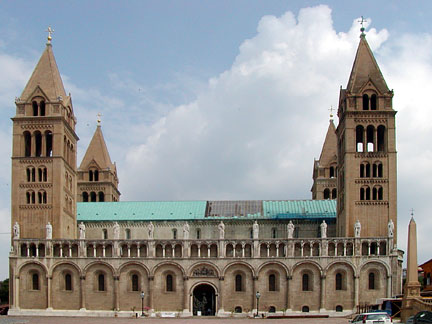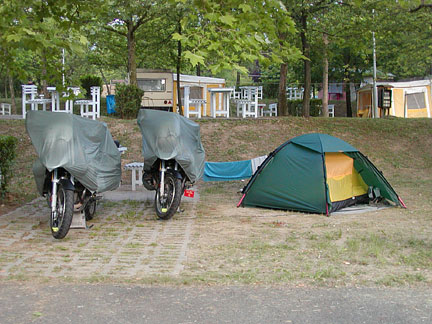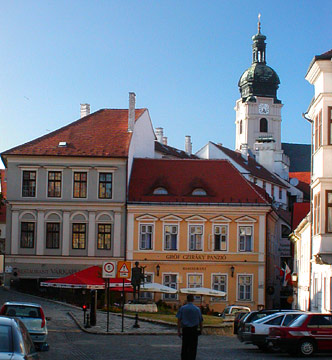|
Transdanubia is defined as the area in Hungary located west of the Danube River. When we entered the country in June 2003 we came into Transdanubia and headed to the city of Pécs.
Pécs is located in Southern Transdanubia and dates from Roman times. In the center of town the Mosque Church can be found which contains Islamic element inside, such as the mihrab (prayer niche) - which always faces toward Mecca (south eastern, in this case), and other distinctive features as can be seen in the photo at left. Evidently there was originally a parish church on this site in the middle ages, but when the Turks arrived in the late 1500’s, the stones of the church were used to build this mosque, which later was used for a Christian church. This former mosque is the largest Turkish building left in Hungary.
|
|
We also visited the Basilica of St. Peter (left) which dates from the 11th century but was rebuilt in 1881. Even though it was entirely rebuilt, it retains the original floor plan from the 12th century and the 11th century crypt. The four towers make it an imposing site. According to a sign on the outside of the building organ concerts are given on Friday evenings.
|
|
|
The Hassan Jakovali Mosque is also located in Pécs - reputed to be the best preserved Turkish building in Hungary. It sits on a side street outside the center of the old town and a much more recent building has been constructed almost on top of it (below, right).
To see more pictures from Pécs, click here.
|
|
|
|
Immediately north of Pécs is the town of Orfú which is located adjacent to two small lakes. We found a campground overlooking one of the lakes and spent one night there. We arrived late in the afternoon on Sunday and every beach on the lake was packed with people enjoying the warm weather. In the morning, our view of the misty lake was a peaceful site (right).
|
|
|
|
|
There are several campgrounds in the Orfú area and one of them overlooks one of the lakes. We pitched our tent for the night and the one overlooking the lake and were delighted to find that there were tables in many of the camp spaces - not something that is often found in European campgrounds.
Lake Balaton, located in Western Transdanubia is the largest freshwater lake in Europe outside Scandinavia at 77 kilometers (47.84 miles) in length. The north western side is considered by many to be the “best” side of the lake and there are many (more than 40) campgrounds on the lake. There are numerous marinas with many sailboats. It appears to be a favorite holiday spot for the Hungarians as well as foreigners. We spent a couple of leisurely days here at a holiday resort obviously catering to the Germans, as about 90% of the car registrations were from Germany.
|
|
|
After a brief sojourn to Romania, we traversed through Western Transdanubia in July, 2003 on our way to Vienna. From Budapest, we headed north toward the border with Slovakia and traveled alongside the Danube to Györ. It is a historic city halfway between Budapest and Vienna. Originally a Roman town, a bishopric was established here in the 11th century and a fortress was built in the 16th century to fend off the invading Turks. The photo at right shows the fortress walls and the bishops palace behind them.
|
|
|
In 1725 the Carmelite church (below, right) and convent were completed. The Convent is now a hotel with rooms along its quiet arched hallways (below, left) with a central courtyard where the 300 year old chestnut trees provides inviting shade for the terrace cafe.
Another treasure in Györ is the lovely baroque statue of the Ark of the Covenant dating from 1731 (below right).
There are many buildings from the 1700s and 1800s throughout the city, most of them nicely restored an maintained. We were particularly impressed with the curved wall in the photo above left. The building on the left curves slightly around the one at the right. We are not sure if it was actually planned that way or just happened at the time of implementation, but it makes an interesting statement about the building styles of the time. The church tower behind the buildings is the cathedral built in the 17th and 18th centuries.
After Györ, we took the short trip to Sopron near the border with Austria. This is another picturesque town that is a joy to wander through. The old quarter is small and now sits in the center of a bustling business center.
It is worth the stop to walk the quiet streets and enjoy the historic buildings. The Turks never attacked this town, so almost every building is historically important. At left is the Storno House (above left in picture), a famous Renaissance palace from 1560 that now houses a museum and gallery. The tower behind the Storno house is the Fire Tower atop the city’s northern gate (also pictured at right). The tower’s 2 meter thick square base was built upon a Roman gate and dates from the 12th century. The cylindrical middle and arcaded balcony were added in the 16th century and the baroque spire was added in 1680.
|
|
The church (left) in the central square is the 13th century Goat Church whose name comes from the heraldic animal of its chief benefactor. The column to the right of the church is the Holy Trinity Column from 1701. All told, a wonderful tour through history.
|
|
|












